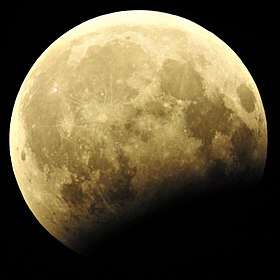October 2005 lunar eclipse
A partial lunar eclipse took place on October 17, 2005, the second of two lunar eclipses in 2005. A tiny bite out of the Moon may have been visible at maximum, though just 6% of the Moon was shadowed in a partial eclipse which lasted for 56 minutes exactly and was visible over east Asia, Australasia, and most of North America. A shading across the moon from the Earth's penumbral shadow should have been visible at maximum eclipse.
| Partial lunar eclipse October 17, 2005 | |
|---|---|
_(cropped).jpg) From Akita City, Japan, 12:21 UTC | |
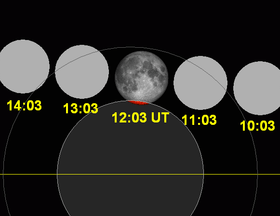 The moon's path through the northern edge of the Earth's umbral shadow | |
| Series (and member) | 146 (10 of 72) |
| Date | 17 October 2005 |
| Duration (hr:mn:sc) | |
| Partial | 55:58 |
| Penumbral | 4:19:49 |
| Contacts | |
| P1 | 9:53:27 UTC |
| U1 | 11:35:18 |
| Greatest | 12:03:22 |
| U4 | 12:31:16 |
| P4 | 14:13:16 |
 |The moon's path across shadow in Pisces | |
The tables below contain detailed predictions and additional information on the Partial Lunar Eclipse of 17 October 2005.
Eclipse Characteristics
Penumbral Magnitude: 1.05856
Umbral Magnitude: 0.06256
Gamma: 0.97960
Saros Series: 146th (10 of 72)
Opposition Times
Greatest Eclipse: 17 Oct 2005 12:03:31:8 UTC (12:04:26.6 TD)
Ecliptic Opposition: 17 Oct 2005 12:13:38.2 UTC (12:14:43.0 TD)
Equatorial Opposition: 17 Oct 2005 12:57:19.6 UTC (12:58:24.5 TD)
Geocentric Coordinates of Sun and Moon
Sun right ascension: 13.49
Sun declination: -9.4
Sun diameter: 1926.2 arcseconds
Moon right ascension: 1.47
Moon declination: 10.3
Moon diameter: 1933.8 arcseconds
Earth’s shadow right ascension: 1.49
Earth’s shadow declination: 9.4
Geocentric Libration of Moon
Latitude: 4.5 degrees north
Longitude: 1.3 degrees west
Direction: 339.8 (NNW)
Visibility
It was visible from Southeast Asia, the Pacific, Australia and New Zealand after sunset, and in the western side of North America before sunrise.

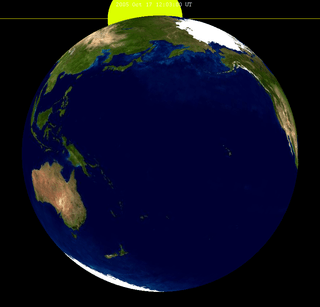
A simulated view of the earth from the center of the moon at maximum eclipse.
Map

Relation to other eclipses
Eclipses of 2005
Lunar year series
It is the last of four lunar year cycles, repeating every 354 days.
| Lunar eclipse series sets from 2002–2005 | ||||||||
|---|---|---|---|---|---|---|---|---|
| Descending node | Ascending node | |||||||
| Saros Photo |
Date View |
Type Chart |
Gamma | Saros Photo |
Date View |
Type Chart |
Gamma | |
| 111 | 2002 May 26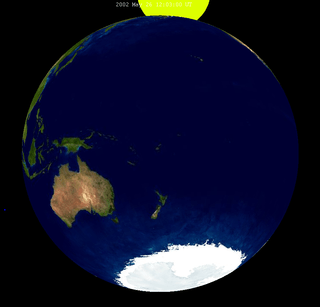 |
penumbral |
1.1759 | 116 | 2002 Nov 20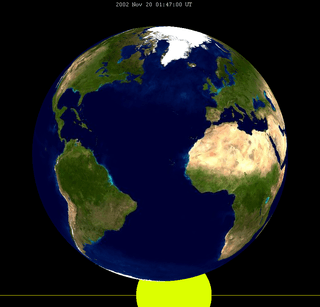 |
penumbral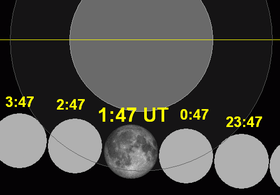 |
-1.1127 | |
121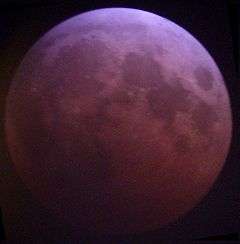 |
2003 May 16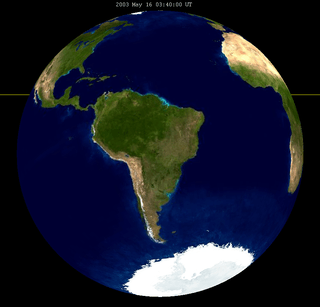 |
total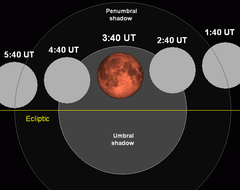 |
0.4123 | 126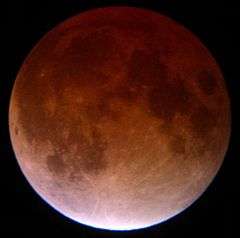 |
2003 Nov 09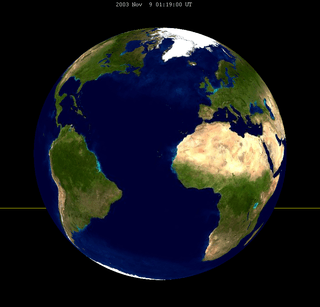 |
total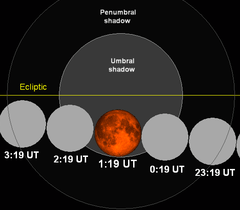 |
-0.4319 | |
131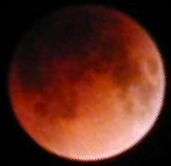 |
2004 May 04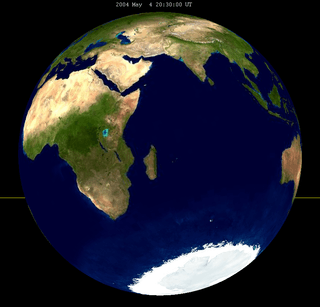 |
total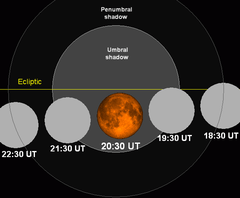 |
-0.3132 | 136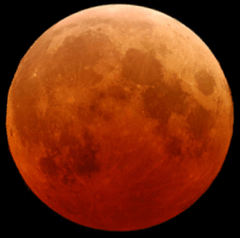 |
2004 Oct 28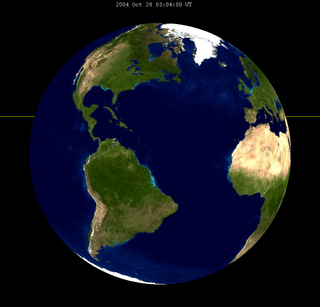 |
total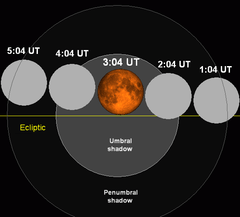 |
0.2846 | |
| 141 | 2005 Apr 24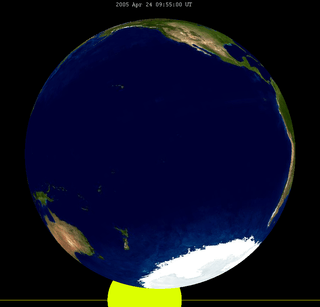 |
penumbral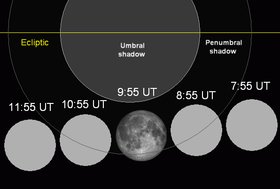 |
-1.0885 | 146_(cropped).jpg) |
2005 Oct 17 |
partial |
0.9796 | |
| Last set | 2002 Jun 24 | Last set | 2001 Dec 30 | |||||
| Next set | 2006 Mar 14 | Next set | 2006 Sep 7 | |||||
Metonic series
This eclipse is the last of four Metonic cycle lunar eclipses on the same date, October 17–18, each separated by 19 years:
The Metonic cycle repeats nearly exactly every 19 years and represents a Saros cycle plus one lunar year. Because it occurs on the same calendar date, the Earth's shadow will in nearly the same location relative to the background stars.
| Descending node | Ascending node | |||||
|---|---|---|---|---|---|---|
| Saros | Date | Type | Saros | Date | Type | |
| 111 | 1948 Apr 23.56 | Partial | 116 | 1948 Oct 18.10 | Penumbral | |
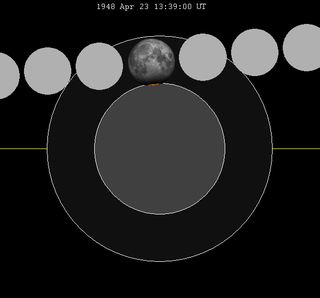 |
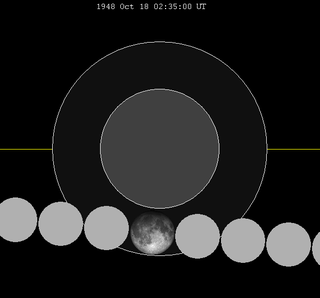 | |||||
| 121 | 1967 Apr 24.50 | Total | 126 | 1967 Oct 18.42 | Total | |
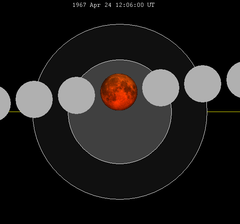 |
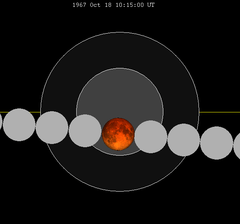 | |||||
| 131 | 1986 Apr 24.52 | Total | 136 | 1986 Oct 17.80 | Total | |
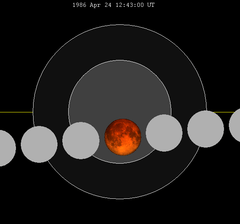 |
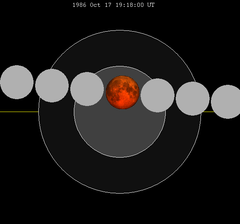 | |||||
| 141 | 2005 Apr 24.41 | Penumbral | 146 | 2005 Oct 17.50 | Partial | |
 |
 | |||||
Half-Saros cycle
A lunar eclipse will be preceded and followed by solar eclipses by 9 years and 5.5 days (a half saros).[1] This lunar eclipse is related to two partial solar eclipses of Solar Saros 153.
| October 12, 1996 | October 23, 2014 |
|---|---|
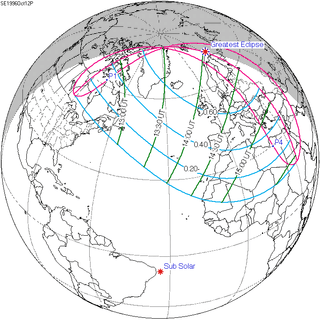 |
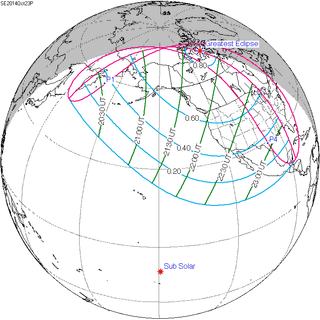 |
See also
- List of lunar eclipses and List of 21st-century lunar eclipses
- May 2003 lunar eclipse
- November 2003 lunar eclipse
- May 2004 lunar eclipse
- File:Visibility Lunar Eclipse 2005-10-17.png
- File:2005-10-17 Lunar Eclipse Sketch.gif Chart
References
- Mathematical Astronomy Morsels, Jean Meeus, p.110, Chapter 18, The half-saros
External links
- http://www.hermit.org/eclipse/2005-10-17/
- 2005 Oct 17 chart: Eclipse Predictions by Fred Espenak, NASA/GSFC
- http://www.space.com/spacewatch/051014_lunar_eclipse.html
- https://web.archive.org/web/20090914132101/http://www.astronomy.org.au/ngn/media/client/factsheet_16.pdf
- Photos
- http://www.starrynightphotos.com/moon/partial_lunar_eclipse_2005.htm Kaituna, Wairarapa, New Zealand
- http://outdoors.webshots.com/album/479147839tyCCAg Taipei, Taiwan
- http://christys-adventuresinlearning.blogspot.com/2008/02/lunar-eclipse-2008.html Seoul, South Korea
| Wikimedia Commons has media related to Lunar eclipse of 2005 October 17. |
